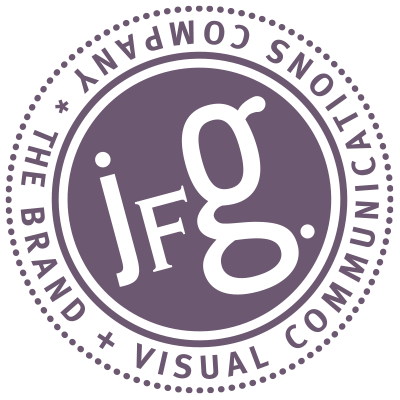Five Reasons Your Start-Up Should Hire a Fractional Creative Director
Have you ever thought of bringing on a fractional creative director? It might be a wise consideration for your start-up while you are in the process of scaling up and need a solid foundation for your business to grow while catering to your customer’s needs.
What is a fractional creative director?
A creative director develops and oversees a brand’s visual communications strategy, including the brand identity and brand expressions applied to content marketing, website, social media, marketing collateral, etc. In addition, a creative director works with marketing and sales to bring the creative strategy, experience, and expertise to the table and oversees creative team members, including writers, graphic designers, and web developers.
A fractional creative director provides all of these services but works with you on a part-time, contract basis. When you work with a fractional creative director, you partner with an experienced professional who helps you progress towards your goals week by week. It is a flexible, sustainable, and affordable way to build your brand. A fractional creative director might work with you one to three days a week for six months or more, depending on your needs.
Why hire a fractional creative director?
A fractional creative director sets your business up for success. Once they understand the goals you have for your business, they can manage the process and help you move your business forward. A fractional creative director will:
Develop a strong brand strategy for your start-up before you go to market. A strong brand identity with robust brand standards provides a solid foundation for business growth. Your brand standards define your company’s purpose, vision, value, and position in the market. It helps you stand out from the crowd and guides your marketing initiatives. The stronger your brand is now, the easier it is to add new elements in the future. If your start-up doesn’t already have this going, a fractional CD can take you through the process so you won’t have to hire an outside resource.
Maintain and evolve the focus of your brand strategy as you grow. A solid and consistent brand builds credibility and inspires brand loyalty—the more people involved with your company, the greater the potential to dilute your brand. As different people take responsibility for your pitch deck, social media, email marketing, presentations, and other marketing and sales collateral, each uses a slightly modified font, photograph, or graphic element, interpreting your brand through their lens. To rein in these interpretations, a fractional CD can oversee what is being put out to the client and remind the internal teams of which guidelines to follow. Not sure where your branding is going? A fractional creative director can always conduct a brand analysis (also referred to as a brand audit or brand assessment) to get back your brand back on track.
Save you money. Instead of hiring a large creative agency or staffing up with junior-level positions, a fractional creative director can work with your existing team to provide the strategy and implementation resources you need. Working with an agency will make sense in certain stages of growth, yet when your start-up is not quite there, contracting a fractional CD will enable you to have the same value and expertise without the agency cost. Often, start-ups hire junior-level staff to save money, which is wise to a degree, but it also comes with a lot of hand-holding, lack of skills, or experience to know what to do when challenges arise. In a fast-paced environment, this might not be ideal. A fractional CD knows what needs to happen and can help mentor the junior-level people to have the guidance and skills they need to grow. Over the long term, the investment you make with a fractional CD will show in the growth and learning of the junior teams. When things get overwhelming, the fractional CMO will be able to step in.
Support your fundraising, marketing, and sales initiatives. It is crucial to have a strong brand strategy during the start-up phase and accompanying visual communications targeted towards prospective investors and customers. A fractional creative director can work with your team to ensure that every communication, from social media to pitch decks to sales demonstrations, showcases your company’s solution and builds your reputation with your audience. A fractional CD can also be an added expert when talking with possible investors by being the voice of their visual communicationns and content marketing strategy.
Be a partner in growing your business. A fractional creative director is a strategic partner who can work with you regardless of whether you have a Chief Marketing Officer on staff. For example, if your company is in the process of hiring a CMO, it might make sense to bring on a fractional creative director now. That way, you can move your marketing initiatives forward while you take the time to make that vital hiring decision. And if you already have a CMO on staff, a fractional creative director can serve as a sounding board and oversee the executive level of visual communications strategy.
To build a sustainable business, you need a strong foundation.
As a start-up organization, you know how important it is to make an excellent first impression. Your company is just breaking into the market and is probably disrupting a few things along the way. To be taken seriously, especially by prospective investors and clients, you need a strong brand, a great idea, and a professional attitude to get the attention of investors. The most effective way to accomplish this goal is to hire a fractional creative director dedicated to your business’s success.
If you’d like to learn more about how a fractional creative director can help you scale your business, contact me today for a 30-minute consultation.
Why a Strong Brand Identity is Crucial for Fast-growth Companies
In a fast-paced startup environment, launching your products and services is ever evolving and very stressful. So, it can be tempting to get a quick-and-dirty logo from a stock logo developer or make it yourself. But a stock logo will not serve you or your company and will, over time, do more harm than good. Just because you have a logo does not mean that you have a brand.
So why is it essential to take the time to create a brand identity the right way? A strategically realized brand identity is the foundation of your business. A brand strategy uncovers and clearly defines your company’s purpose, vision, position, value, and audience. It defines your position in the market and the value you give your client. It helps you make clear, unified, and focused decisions and becomes your roadmap guiding your marketing initiatives.
Not to mention, investing in your brand identity helps ensure that your company stands out from the crowd and will position your company for success from the moment it enters the marketplace.
What is a brand identity?
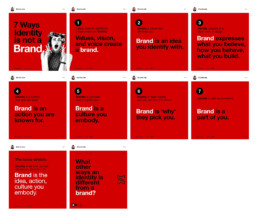
As demonstrated by a guest post by The Meta Shift for Chris Do, the above graphic brilliantly explains why a brand is more than just an identity.
Your brand identity is a combination of the visual and messaging elements that support the essence of your company and how you wish to present yourself to your ideal client or customer. Your brand not only includes your logo but your brand architecture and brand expression.
A logo or identity is a symbol, marker, or typeface used to identify your business. Although it is an essential part of your branding efforts, it is just one expression of your brand identity. A strong logo works in concert with the overall design — including colors, typography, and graphics — to tell your company’s story. Your logo may appear on the web, in print, or on marketing collateral and promotional materials, so it is essential to design your logo to suit each of these executions.
Brand architecture is the organizational structure of your products and services. It defines how each product or service line works with the overarching brand identity and how they relate to one another. It is an integrated system of names, symbols, colors, and graphics that flow together to make it easy for the customer to understand the relationship.
Brand expression is the combination of design, color, typography, and graphics — including photography, illustrations, iconography, patterns, and other visual elements — used by your company to differentiate it in the marketplace. These elements also help shape and define the customer experience by establishing a hierarchy to present information and draw attention to the most critical aspects.
The brand standards or brand guidelines document the rules dictating and interaction between these three elements. Following your brand standards help you maintain a differentiated, authentic, and consistent visual identity. Brand standards help everyone in your company ensure consistency and proper representation of your company in the marketplace, so your reputation is not diluted.
Under what circumstances should you invest in a brand identity?
To determine whether you should invest in brand identity, consider the following questions:
1. Do your audiences expect you to present a professional image?
Suppose you provide professional services or work in the B2B space and seek funding for your company. Your audiences expect a quality product, so it’s essential to present a professional image. A brand identity will help you differentiate your company from the competition and instill trust and confidence in your audience. Clip art, self-created logos, and stock logos won’t cut it. So if that’s what you’re using right now, it’s time to upgrade to a more professional look.
2. Do your business development efforts go beyond referrals?
Suppose you rely on a sales team. They require presentations, demonstrations, pitch decks, digital marketing, advertising, networking, or trade shows to support your business development efforts. Having that strong brand foundation in place and brand standards as your guide, your team will have the tools to guide and drive the design of these various touchpoints. Consistency and cohesion are vital to building a strong brand across multiple platforms.
3. Do you have aggressive growth goals for your company?
If you are trying to attract investors or make other plans to grow your company by hiring an exceptional team, having solid brand standards will help ensure consistency. As your team grows and more people present your company to prospects, customers, and funders, your brand can quickly become muddy. When your visual identity is inconsistent because your team uses different fonts, colors, and graphics, your audience may question your competence and professionalism. And your brand will start to feel disjointed and chaotic. The trust that you have worked so hard to build will dissipate. Without a strong brand identity and standards, over time, your brand becomes diluted.
A brand identity provides a solid foundation for business growth.
People trust companies that have a consistent and cohesive look. If you spend money on a logo and website now and have to change it in six months, it’s going to cost you time and money. But if you take a long-term vision for your business, you can focus your energy and efforts on growth.
Trust reassures prospective customers and investors that your solution is a worthwhile investment. Investing in a strong brand identity now will make it easier to add new graphic elements down the line, so your brand can evolve along with your business. The good news is that investing in a strong brand identity doesn’t have to break the bank. A good designer can help you can get started with a simple logotype, color palette, information hierarchy, and brand standards document. They will also make sure your brand assets are available in multiple file formats, so you can use them however you’d like!
Creating a brand that can evolve with your business is perhaps the most important reason to partner with a visual communications expert. If you’d like help shaping your brand so it portrays your business more effectively, let’s talk.
Three Reasons Fast-Growth Companies Should Conduct a Brand Analysis. Immediately.
Working for a startup is exciting. The team consists of a small group of talented and dedicated people willing to do whatever it takes to succeed. For fast-growth companies, those challenges that were once so exciting become frustrating as the founders give up control and more people get involved in the business.
Some of these growing pains are internal, but these challenges play out in public when it comes to a company’s visual identity and messaging.
Maintaining the focus of your brand identity over time is a challenge. As more and more people interpret your brand and do their best to present the company to prospects, customers, and funders, the brand becomes muddy. Each person responsible for developing marketing and sales collateral interprets the brand differently, favoring specific fonts, colors, or graphics. These modifications may seem inconsequential at first, but over time they give your audience the impression that your company is not as capable or professional as they once thought.
What is a Brand Analysis?
Also referred to as a brand assessment, a brand analysis evaluates every touchpoint between your company and your audience to ensure your brand is consistently and properly represented. It looks at the current state of your brand and its position in the marketplace. It creates a clear path forward so you can reinstate and maintain a differentiated and authentic visual identity. It identifies what’s working well, what’s not working, what’s missing, and the best course of action to take to close the gaps and move forward.
A brand analysis doesn’t just look at your logo and website. It reviews and evaluates your social media, email marketing, presentation decks, webinar slides, white papers, and promotional materials — every single piece of outward-facing collateral used to present your company to your prospects, customers, and funders. It looks at the treatment of each element to make sure it is consistent with your brand standards (if available) or the overall look and feel of your brand. Is the typography consistent? Are the icons all of a similar style? Is there a specific color palette? Do the photographs have the same look and feel and do they reflect the brand?
Why is it Essential for Fast-Growth Companies to Conduct a Brand Analysis? What Are The Benefits?
A brand analysis gives you a clear path forward so that you can present your company in the best possible light to customers, prospects, and funders. It is critical for fast-growth companies because:
1. A Complete Brand Analysis Saves Money
The sooner you do a brand analysis, the more money you will save. Not only will the assessment be more limited in scope, but you won’t need to redesign as many creative assets. By conducting a brand analysis, you will know which elements of your brand are working well and do not need to be changed. You’ll also know which elements need to be brought into alignment with the brand immediately and which are currently missing. You won’t have to waste valuable time and money reinventing the wheel. The stronger your brand is now, and the more robust your brand standards are, the easier it will be to add new graphic elements down the line.
2. Brand Consistency Instills Brand Loyalty
Consistency in how you present your company has a tremendous influence on your customer experience. Have you ever gone to the grocery store to pick up your favorite product only to realize that they’ve changed their packaging? That change raises questions about whether you should stay with that particular brand. Is this really what I’m looking for? Is it the same company? Is this a new product or just new packaging? Will it be as good? A brand analysis makes sure your audience recognizes your company at every point along the journey.
3. A Professional and Cohesive Brand Inspires Confidence
A brand that has a cohesive look and feel is trustworthy. A brand that is erratic is perceived as unprofessional. As you continue to grow your business, you will need to attract new customers and funders. A strong brand reassures your prospective customers and funders that your solution and company are worthwhile investments. A consistent look and feel helps your company build its reputation and credibility.
A Brand Analysis Removes Obstacles to Growth.
Working for a fast-growth company, you don’t have the time to redesign your pitch deck (yet again) or frantically search for the right logo. You need to streamline the process, so your company always puts its best foot forward. A brand analysis provides you with a written set of recommendations that you can implement immediately, provides insights into what might be missing, and finally suggests what you might try to enhance your client experience. It gives you the information needed to develop or update your brand standards, which will help ensure that your brand stays consistent moving forward. Having evaluated your digital assets, you are now well-positioned to organize them in a digital asset management system that can be accessed by your entire team. Finally, the brand analysis recommendations highlight other areas for improvement for all of your brand touchpoints.
If you work for a company preparing for exponential growth, get in touch. I’d love to work with you to help you achieve those growth goals by presenting your company as the very best solution in the market. If you are interested in learning more about how your company can benefit from a Brand Foundation Analysis, let’s talk.
The Power of Relationships to Build a Thriving Business
I’ve been thinking a lot about what it means to build a thriving business. Apparently, I’m not alone. Conduct a search on Google or peruse the shelves at your local library or bookstore, and you’ll find countless articles, checklists, books, and videos on this topic. Many of these focus on establishing a strong foundation for your business.
For example, in Mission in a Bottle, Seth Goldman and Barry Nalebuff share their insights on how to build and scale a successful business. The founders of Honest Tea, which is now a $100 million enterprise, share this advice with their fellow entrepreneurs: it starts with identifying your real purpose and building something you believe in wholeheartedly. They appeal to each of us to dig deeper and build a business that is radically different, a business others will try to imitate. And they remind us to prepare for the setbacks, the missteps, and simple bad luck that strikes every entrepreneur at one time or another. Building a successful business requires you to take the long view. There are no shortcuts.
But how do you elevate a successful business to a thriving one?
A successful business is profitable. A thriving business is not only profitable but regenerative. It unlocks new levels of innovation, cultivates human potential, and achieves extraordinary results. A thriving business is steeped in Self-determination Theory, which focuses on the degree to which human behavior is self-motivated and self-determined. As described by organizational psychologist Dr. Benjamin Hardy in Who Not How: The Formula to Achieve Bigger Goals Through Accelerating Teamwork, we thrive in our work when it provides us with a sense of competence, autonomy and is rich in meaningful relationships. Relationships are vital, for we can’t do it alone.
According to Who Not How: instead of thinking of how to achieve something, if we identify a who to guide us through, we efficiently and effectively complete the goal. When I partner with my clients, we create strategic communications highlighting their products and services to convey a powerful message specifically to a well-defined audience. My clients achieve their goals by working with me, and in return, I contribute to the growth of their business. It is by contributing to the growth of my clients’ businesses that I achieve my goals as a graphic designer and business owner. It’s unbelievable what we can accomplish when we’re all working towards the same goal. This is what distinguishes a thriving business from a successful one.
How to nourish the three key relationships that help you build a thriving business
Strategic networking and targeted outreach campaigns allow you to connect and build relationships with prospective clients and referral partners. Let’s not leave out how you work with your employees or contractors who become a part of your team. These are the relationships you need to develop and nurture if you wish to build a thriving business. Here’s how you build each of those key relationships:
1. Be the solution your clients seek
Your clients have a problem, and they are in need of a solution. Depending on how long they have been struggling, they may have tried a few solutions already. Perhaps they tried to solve the problem themselves. Or perhaps they hired someone to solve the problem and it didn’t work. Either way, they are probably frustrated and skeptical. To be the solution your clients seek, you have to take the time to get to know them, their company, their goals, and their challenges.
2. Be a resource for your referral partners
Your referral partners understand the challenges their clients are facing and often know who is in the best position to address those challenges. Their goal is to be a trusted advisor, someone who can help their clients solve the problems they encounter. To be a resource for your referral partners, give them the tools they need to be a hero to their clients.
3. Be the conduit for your team to achieve their goals
Your team includes employees and independent contractors. They want to spend their time doing their best work. They want to feel valued and competent and be granted the autonomy they need to get their work done. To be the conduit for your team to reach their goals, you have to relinquish control over how things get done. In so doing, you will not only help your team achieve their goals, but they will help you surpass your goals.
The best relationships give and take.
In a healthy relationship, both parties give and receive support. That’s just as true in business as it is in our personal lives. As you seek out and build your relationships, keep in mind that you are not only seeking their support to reach your goals but offering to help them reach their goals as well.
If you’re looking for help to build your thriving business, schedule a free 30-minute consultation today.
Three Benefits of Partnering With a Graphic Designer
All professional graphic designers understand the basics of design: layout, grids, color theory, typography, but the very best also have a deep understanding of strategy and how it applies to marketing and branding. The best designers understand how the value of exceptional design, created with a purpose, adds to a business and brand growth. Strategic understanding is crucial. We see how all of the pieces fit together and understand the role visual elements play in bringing your brand story to life.
There are several benefits to hiring a graphic designer for specific projects. A good graphic designer will save you time and money, ask smart questions, and provide plenty of value without needing to be micromanaged. We are a dependable and resourceful lot: finding creative solutions to business problems is what we do.
But the benefits are so much more significant, and our work together is truly transformational when we establish a partnership. Graphic design is a critical business asset that has the potential to transform your business. But you can’t get a transformational result from a transactional relationship
Why to partner not just hire. Three benefits of partnering with a graphic designer.
Whether you are a business owner, founder of an entrepreneurial startup, marketing consultant, or chief marketing officer, you owe it to yourself to partner with a talented branding and visual communications expert. Here are a few you can benefit from partnering with a graphic designer:
1. Find creative solutions to business challenges.
The best graphic designers have a deep understanding of branding and marketing strategy and can help you create and implement a plan to grow your business. It all starts with establishing a strong brand that resonates with your audience. Your brand is your business’s personality, and every graphic element has to evoke the right emotion. It might be adventurous or cautious, energetic or calm, traditional or innovative. A strong brand has a strong personality. It captures how you want your audience to feel when they first encounter your business.
Your marketing strategy is built on your brand strategy and messaging. Whether your goal is to launch a new business or a new product, expand your reach, or spread the word about an upcoming event, your marketing strategy will outline the tactics and touchpoints to make it happen. And from that marketing strategy, you can create a list of marketing collateral to develop — from brochures, direct mail pieces, and conference swag to digital ads, infographics, and social media posts.
The sooner you partner with a graphic designer, the more you will benefit from their insights and in-depth understanding of branding and marketing. By partnering with a graphic designer, you’ll be able to build a strong brand and convey a clear and compelling message.
2. Make a great first impression.
You only have one chance to make a great first impression. In many cases, that first impression is informed by the quality of your website and other marketing collateral. Good design gives your business credibility. It builds trust with your audience and positions your company as the best solution to the problems that keep your clients up at night.
But if the design is unprofessional, how can your clients trust that your company can provide the solution they need?
A clear, unique, and memorable marketing message must be accompanied by an equally compelling visual system that represents your brand. A good designer gives shape to your brand while adding ideas to develop a strong visual identity that speaks to your audience.
3. Be consistently seen and heard by your audience.
You can’t earn your audience’s business without first gaining their trust. And you can’t gain your audience’s trust without showing up consistently with a clear and compelling message. Great design amplifies your message, helps you earn your audience’s trust, and builds brand recognition.
In today’s business world, your online presence — your website, social media, email newsletter, and digital advertising — is the most effective tool to make sure you are seen and heard by your audience. A user-friendly website that is responsive and accessible is a powerful communication tool and at the heart of any online communications effort. Social media, email marketing, and digital advertising expand those efforts, converting your prospects into clients. Print materials subsidize your online presence, deepening the relationship with your audience.
Related article: Fix your Social Media Schedule Struggles with SocialBee
Are you ready to partner with a graphic designer?
In an increasingly competitive market, being average isn’t good enough. Your marketing needs to be exceptional to cut through the noise and be noticed by your target market. By partnering with a graphic designer who will put in the time to research your company and your competition, understand your audience, identify your business challenge, and create marketing collateral that responds to the needs of the people you serve, you will stand out from the crowd.
Your time is too valuable to spend doing anything other than what is within your zone of genius. Instead of trying to do it all yourself, build a team of trusted experts who can help you reach your goals. As Dan Sullivan and Dr. Benjamin Hardy wrote in Who Not How, successful growth depends on changing your mindset from asking how you will accomplish your goal to asking who will help you accomplish your goal.
Are you looking for a creative partner for your business — a who to take on the how of branding and visual communications? If so, give me a call.
Defining Your Marketing Strategy: Content Marketing
Your marketing strategy outlines the tactics you use to communicate with your ideal clients. It is derived from your brand strategy and is one of the three key strategies every successful business needs. According to Ilise Benun of Marketing Mentor, an integrated marketing strategy consists of targeted outreach, strategic networking, and content marketing.
This post is the final in a three-part series that reviews each of these elements to focus your marketing efforts. The first post focused on targeted outreach. The second post gave a few tips on how to engage in strategic networking virtually as well as in person. This month, I am focusing on content marketing, emphasizing how design can help you differentiate your content marketing efforts.
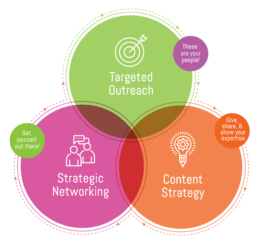
What is content marketing?
Content marketing uses content to speak to your audience, including your ideal clients and referral sources, so they will remember you when they need you most. Good content allows your audience to learn about your expertise; it shows them that you understand their problems and have a solution.
Content marketing ties your marketing strategy together. As you get to know your audience, you will better understand the challenges they face. The more you understand their challenges, the better positioned you will be to create content that addresses those needs. You can then use the content you create to nurture the prospects you identified as part of your targeted outreach efforts. To stand out, you want to create content that is in keeping with your brand. That’s where good design can help.
How can design increase the effectiveness of your content marketing efforts?
While blogs and email newsletters are the most common type of content, effective content marketing uses a mixture of written, visual, interactive, and video content. Each type of content presents information differently, which ensures that you are reaching and engaging your audience. In some cases, it may make sense to combine several formats into one piece. For example, you might incorporate an infographic into a blog post, like this example I created for Datacolor, appealing to visual learners versus those who process information through the written word.
Visual language is an integral part of your content marketing effort. By applying uniquely created design elements to your content, the applied designs support your underlying message and enhance understanding. It is also critical to successfully repurposing content, which reinforces your original message, increases reach (the number of people who see your message) and frequency (the number of times a person sees your message), and drives traffic to the original piece of content.
Related Article: Defining your Marketing Strategy Part 1: Targeted Outreach
Design considerations for five of the most effective content formats:
1. Blog posts are the most common type of content.
In most cases, the blog post incorporates a hero image. Because many companies use stock photography, this is an excellent opportunity to stand out from the crowd and reinforce your brand with a custom graphic. Not only will it be specific to your topic, it will also reinforce the identity of your brand. Blog posts can also incorporate other graphic elements, such as an infographic, customized quotes, and collage. In addition, you can promote through social media, utilizing the created graphics to support the post content.
2. Infographics are the most popular and widely shared type of content.
Infographics are visual representations of complex ideas. They tell a compelling story that many audiences find incredibly engaging. They are often embedded in a blog post and shared through social media. The most effective infographics have very few words: they rely on the power of visual language to convey their message. Not sure where to start? Maybe create a timeline of your business from where you started and show the growth to where you are today. You can break infographics into several pieces of content to share on social media.
3. Webinars and presentations build authority.
The most effective webinars and presentations support the speaker’s story. They have very few words but are rich in graphics, which is essential to keeping your audience engaged. Images, graphics, and typography work together to reinforce the message. Elements from a webinar or presentation can also be used on social media or repurposed into a blog post or ebook.
4. Ebooks are powerful lead magnets.
Ebooks demonstrate your expertise and help your audience understand your approach. Good design helps make the information presented more digestible, making ebooks excellent candidates to repurpose into infographics. If you intend to use an ebook as a lead magnet, you may also want to develop a landing page making sure the branded graphics are carried all the way through.
5. Distribute content through email newsletters and social media.
For every piece of content you create, you will want to make sure it is distributed to your audience and promoted through online platforms to reach an even broader audience. Your email newsletter is an excellent distribution channel, and social media serves both to distribute and promote your content. It should go without saying that your brand elements will drive the look and feel of the content message.
Related Article: Defining your Marketing Strategy Part 2: Strategic Networking
Are you ready to be strategic about your content marketing?
Have you thought about how design can increase the effectiveness of your content marketing efforts? Do you know how to repurpose your content to improve reach and frequency? From designing landing pages, ebooks, webinars, infographics, email newsletters, and social media posts to determining the best graphics to accompany your blog post or figuring out how to repurpose existing content, I can help you stand out and get your audience’s attention.
If you would like to take your content marketing to the next level, let’s talk.
Defining Your Marketing Strategy: Strategic Networking
Your marketing strategy outlines the tactics you use to communicate with your ideal clients. It is derived from your brand strategy and is one of the three key strategies every successful business needs. According to Ilise Benun of Marketing Mentor, an integrated marketing strategy consists of targeted outreach, strategic networking, and content marketing.
This post is the second of a three-part series that reviews each of these elements to help you focus your marketing efforts. Last month, I focused on targeted outreach. This month, I am focusing on strategic networking, which has looked a little different this year due to the pandemic.

What is Strategic Networking?
Strategic networking is the skill of building relationships. Relationship-building should be the most natural thing you do, but often it is one of the hardest. While you never know who might be able to introduce you to your next perfect client, networking takes significant time, energy, and effort. It is finding the ideal client, the advocate, or community who will benefit the most from your product or service. Consistent nurturing of these relationships helps in being remembered when you are needed most. Without these relationships, your business cannot thrive, much less survive.
How Do You Engage in Strategic Networking During a Global Pandemic?
In March 2020, all in-person gatherings came to a halt, and we all became used to video conference calls and working from home. Although there have always been a core group of networking events hosted online, there are even more today than there were just a few short months ago. You can find several virtual networking events on sites like Eventbrite, Meetup, LinkedIn, LunchClub, and Blitzr. Most associations are also hosting their events online.
One of the benefits of virtual networking events is that you typically get more time to connect with individuals one-on-one than at a traditional networking event. There are also fewer distractions, so conversations tend to be more focused. In some cases, the host sets the tone for the conversation and presents a clear discussion topic. In other cases, the event starts with a speaker. In either case, it pays to be prepared. It’s also important to capture the names and contact information of people you want to connect with after the event. An easy way to get started is to send a connection request on LinkedIn that reminds your contact where you met. Once you’re connected, you can set up a one-to-one phone call to continue the conversation.
Five Steps to Focus Your Virtual Networking Efforts
1. Focus on Building Relationships.
To communicate your expertise effectively to your potential ideal client, you must nurture the relationship allowing them to get to know you. As this crazy year has unfolded, we have had to adjust and create new relationship-building techniques. I’m sure you have heard of creating personas by identifying your ideal clients’ characteristics. However, have you heard of relationship-marketing personas? These personas focus on loyalty and long-term engagement. The goal of relationship marketing is to create strong, even emotional, client connections that can lead to ongoing business, free word-of-mouth promotion, and information from your ideal client that can generate leads.
From your research conducted for your targeted outreach, consult your list, and begin searching for events that might lead to introductions to personas who fit the bill to start your relationship-building process. According to Fast Company, networking isn’t about just meeting people; it is also setting up the method of sustaining these relationships. It’s not the small conversations that will make a friend and colleague for life. It’s a mixture of many things that will connect you to your ideal client.
Get started: Create relationship-marketing persona profiles of your ideal client, advocate, and community. Be descriptive of their likes, dislikes, where they hang out, what associations they are active in, what social channels they use, etc.
Related Article: Defining your Marketing Strategy Part 1: Targeted Outreach
2. Go Where Your Ideal Clients Gather.
Not all networking events are created equal. Find the ones that work for you and your ideal clients. What industry trade associations do your clients belong to? What conferences do they attend? What resources do they rely upon to do their jobs? Are they active on LinkedIn? What groups or online communities do they belong to? What are the topics being offered via Blitzr or Eventbrite? It’s essential to network with colleagues in your industry, but make sure you also network with your prospective clients.
Next steps: Join a relevant industry trade association and plan to attend a virtual conference or event of interest to your clients.
3. Understand Your Ideal Clients’ Needs.
Do your research so you understand your ideal clients’ challenges and frustrations. Go to the event to be helpful, and ask open-ended questions to encourage conversation. Connect authentically, and listen to understand. Although you may not be able to solve their problem, you might be able to make an introduction or refer them to someone who can. Be generous with your time, connections, and expertise.
Be prepared: What are the challenges your clients face regularly? Whom do you know who can help them? Understand your clients’ needs so you can demonstrate your value from the very first conversation.
4. Make the Most of the Event.
To make the most of any networking event, it helps to do a little research in advance. If possible, get a list of the people planning to attend and learn as much as you can about them. You probably won’t talk to everyone, so have a shortlist of two or three people you want to connect with. Have some questions prepared in advance. Instead of asking what they do, try asking them to tell you about a project they’re working on that they are excited about. By breaking the pattern, you gain their attention and open the door to real connection. And when you connect with someone, make sure you get their LinkedIn URL so you can follow up! Finally, if you have a hard time starting conversations with people you don’t know, ask the event organizers how you can help. By serving on a committee or volunteering at an event, other people are more likely to seek you out and initiate the conversation.
Continue the conversation: At virtual events, take notes about your fellow attendees so you can connect with them on LinkedIn. Refer back to the event, so your new contact remembers how you met, and start a dialogue. One good place to start is asking for their opinion about the main topic discussed at the event you both attended. Online conferences generally have a chat function alongside the presentation in which to converse. Conference hosts also use Slack, designating a separate channel for each of the topics, talks, and sponsors. Slack is a great place to connect and share your contact information with the other conference attendees.
5. Nurture the Relationship.
Building a relationship takes time. It’s essential to follow-up consistently and with intention. A new connection rarely results in a new client immediately. It often takes several months before your connection is ready to be a client. But by sending articles of interest, commenting on their LinkedIn posts, introducing them to other people who might be valuable connections, and chatting with them about the things going on in their lives, not just about business, you can build that relationship over time. And even if they never become a client, you now have someone in your network who might serve as a sounding board, mentor, referral source, or cheerleader.
Follow up: Stay in touch. Whether you send a handwritten note, share resources, or make a valuable introduction, continue to nurture the relationship.
Related Article: Defining your Marketing Strategy Part 3: Content Marketing
Are You Ready to be Strategic About Your Networking?
How have your networking efforts changed during this time? Have you had experiences with the virtual arena that has changed how you find your ideal clients? Have you experienced the nurturing of relationships to be a bit easier? I would love to learn about what virtual event opportunities have come your way and how you are navigating these crazy waters!
Defining Your Marketing Strategy: Targeted Outreach
Your marketing strategy outlines the tactics you use to communicate with your ideal clients. It is derived from your brand strategy and is one of the three key strategies every successful business needs. According to Ilise Benun of Marketing Mentor, an integrated marketing strategy consists of targeted outreach, strategic networking, and content marketing. This post is the first of a three-part series that reviews each of these elements to help you focus your marketing efforts.

What is Targeted Outreach?
Targeted outreach is a focused, time-bound effort to connect with a list of specific individuals who fit your ideal client profile. Your primary goal is to start a conversation with your prospective clients so you can establish trust and build a relationship. One way to connect is through an outreach campaign. Your campaign should be comprised of a series of steps and a combination of tactics designed within a scheduled timeframe. Each touchpoint should be uniquely created to achieve a specific, measurable goal. Whether you decide to send a series of emails, a printed piece, or both, ask yourself, what is the best way to reach out to your ideal prospects? Below are five steps to help you develop and effective target outreach campaign:
1. Define Your Audience
Whom are you trying to reach? To run an effective targeted outreach campaign, you need to know the name, title, and contact information of the 25, 50, or 100 individuals with whom you want to build a relationship. Make sure you have the right contact person at each company and refine your list until it includes only the most qualified prospects. As you define your audience, you’ll start to learn about the conferences they attend, the associations they belong to, and the resources they rely upon to do their jobs. You may also see how active they are on social media or how involved they may be with specific organizations. This information will help you decide on the best way to approach them.
If you need a place to start: Make a list of 50 companies with whom you’d like to do business. To compile this list, start with your LinkedIn connections or other members on an industry-focused Slack channel. But don’t stop there. Review the membership lists of relevant associations or use a searchable database like AtoZDatabases.
2. Do Your Research
Now that you have your list in hand, it’s time to understand what each person on the list is struggling with that you could solve. The more you understand their challenges and what they’ve done to solve the problem, the more effectively you can tailor your message. Think about why the people on this list should work with you instead of another service provider. What’s in it for them? Research their company websites and social media channels. Define why they are your ideal client and how you can help them. Try to discover areas or topics that you are both passionate about and see if you can find common ground or a shared connection.
If you need a place to start: One of the easiest ways to understand your prospective client’s challenges is to speak to them directly, but cold calling isn’t always successful or comfortable. So instead, start by reviewing their LinkedIn profile. Do you have any company affiliations in common? Did you attend the same college or university? Do you have a shared connection? Perhaps both of you are members of the same group on LinkedIn? Did you attend the same event? Find things that connect you and them, and incorporate those commonalities into your outreach message.
3. Craft Your Message
Okay, so you have your list, and you’ve done your research. Now it’s time to choose the words that best speak to your prospective client’s challenges and pain points. Your message has to answer one question: what’s in it for them? It isn’t a pitch. It’s a conversation starter, and your goal is to elicit a response. Your outreach campaign should talk to them not as a service provider to a prospective client, but as a friendly colleague looking to build a long-term relationship. Show that you understand the challenges and their pain points. Speak to their needs and aspirations, and acknowledge their accomplishments. Be authentic and creative, and show them how you are uniquely qualified to solve their problem. Each time you follow-up, or provide information that they can use, you add more value to the conversation. (This is where the overlap with content marketing comes into play.) As you develop these messages, think about how each message naturally leads to the next, leading your prospect to respond.
If you need a place to start: Decide how you want to reach out to the people on your list. Do you want to use LinkedIn? A personal email? A direct mail piece? In each version, what are you asking? What is the overarching message that addresses their challenges and pain points? How are you showing that you know about their business and can help? Can you come up with a creative concept that would grab their attending and speak to their challenges, needs, or business aspirations?
Related Article: Defining your Marketing Strategy Part 3: Content Marketing
4. Define Your Campaign
So with steps 1-3 complete, how will you best reach out? It can take up to 10 touches to convert a lead into a customer, so you’ll need to craft a robust follow-up sequence that encourages the recipient to engage with you. Review your research, findings, and customized messaging and clearly define the purpose and timeframe of your campaign. I find that a combination of direct mail and email marketing is an effective method. These efforts can be supported by reaching out on social media as well. Be creative and think outside of the norm. For your direct mail campaign, go beyond the postcard. Consider creating a customized package to serve as the cornerstone of your campaign. Create a series of follow-up email messages that carry the campaign theme forward and deepen the relationship.
If you need a place to start: Conduct a three-month, targeted outreach campaign to secure 25 clients next quarter. In month one, reach out with a direct mail piece, follow-up with an email asking if they received it, and send a connection request on Linked In. In month two, let them know you’ll be attending a conference where their CEO is speaking and try to set up a time to meet. In month three, attend the conference and, afterward, call your prospect to share notes about the experience and determine if there is any interest in a further conversation. Set your goals and make sure they are SMART — specific, measurable, attainable, relevant, and time-bound.
5. Build the Relationship
With all your efforts, your ideal clients are bound to take notice. Timing is everything; even though they may not need you at the time of the campaign’s last touchpoint, it doesn’t mean that they won’t remember you when the need arises a few months later. Persistence and consistency are vital. Even after your campaign’s engagement ends, keep building the relationship through the connections you established.
You’re connected. Now what? Continue to send valuable resources and nurture that relationship. Introduce them to someone else who works in the same industry, if you think that relationship will add value to both parties.
Are You Ready to Launch a Targeted Outreach Campaign?
A targeted outreach campaign is one of three legs of your marketing strategy. It works in concert with strategic networking, which may help you identify prospects for your targeted outreach, and content marketing, which provides at least some of the valuable content you share in your outreach campaign. By creating and implementing a comprehensive marketing strategy, you will attract more of the right-fit clients.
Are you ready to focus on your marketing strategy and need assistance in launching a targeted outreach campaign? Let’s talk.
Three Strategies Every Successful Business Needs
Having a solid strategic foundation created with intention, followed with persistence and consistency, will pave the way to success and impact your business’s growth. How? By having a strategy for your brand, your marketing, and your content, this foundation trifecta will drive all the elements needed to thrive. Let’s start with some definitions. Yes, many articles on this very topic overlap, are layered with confusion and opinions, but I hope to simplify it all to prove a point. So here it goes:
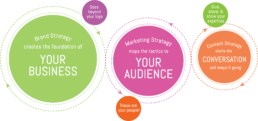
1. Brand Strategy
A brand strategy clearly defines your company’s purpose, vision, position, value, and client. It’s your definition of your position in the market and the value you give your client. It helps you make clear, unified, and focused decisions and becomes your roadmap guiding through your marketing initiatives. Your brand strategy only changes if your destination does. This strategy sector also includes creating a blend of visuals and voice, so what you look like and how you say it is consistent. These are the tools that your client will get used to seeing and, if you are persistent, over time, they will get to know you.
Debbie Millman, a highly regarded brand expert, describes branding as deliberate differentiation based on Harvard Business School’s Michael Porter’s definition, “Strategy, which is one of two things: It’s either to choose to perform activities differently or to perform distinctly different activities than your competitors.” To think of branding as deliberate differentiation will help you set your company apart. Aim to create a brand that is unique to you and what you offer. Add authenticity and transparency as a constant reminder of how you shape and form the brand you represent.
If you need a place to start: Complete a discovery phase with a brand strategist to help answer all the questions and create guidelines that drive the content and graphics that need to support these findings. Have the brand strategy in writing, and refer to it consistently to help you stay on track. Modify if something isn’t working and update as the market or your ideal client’s needs change.
2. Marketing Strategy
Marketing strategy is derived from your brand strategy. It outlines the tactics you will use to communicate your key messages to your ideal clients. It includes your content strategy, digital marketing, campaign development, social strategy, advertising, public relations, etc. and supports all your marketing initiatives as part of your overarching business plan.
Marketing coach Ilise Benun of Marketing Mentor developed an effective methodology that combines targeted outreach, strategic networking, and content marketing.
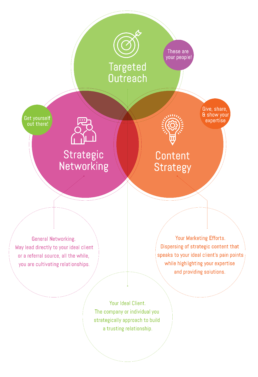
Targeted outreach is directly reaching out to your ideal client. Once you have done your research and identified those individual prospects, specific individuals at specific companies, you can reach out to them and build a fruitful relationship.
Related Article: Defining your Marketing Strategy Part 1: Targeted Outreach
Strategic networking is a broader approach than targeted outreach. It is the skill of building relationships. Whether or not someone is your direct target, you never know who might be a valuable referral source or a keen connector.
Related Article: Defining your Marketing Strategy Part 2: Strategic Networking
Content marketing ties your marketing strategy together. Using your content to speak to your audience will keep your content and intention in front of your ideal client and referral sources to remember you when they need you most. With consistency and persistence, the right person will see the content at the right time and will reach out to work with you.
Related Article: Defining your Marketing Strategy Part 3: Content Marketing
If you need a place to start: Know your audience. Choose the tactics that will address their pain points through initiatives that will reach them. Don’t waste your time doing things that you think you should – do your research and be in the places where your audience is spending time. Once you have found the tactics that work best for you, be persistent and consistent with your outreach and message. Start the conversations that will interest your audience in participating.
3. Content Strategy
Content strategy refers to the planning, development, and management of content, bridging your expertise to the pain points of your ideal client. It also includes the distribution of such content to make sure you connect with the right people at the right time and in the right place.
According to entrepreneur, content marketing strategy, at its core, is your “why.” Why are you creating content? Whom are you helping? How do you connect with your ideal client in a way no one else can? As a business, strategically using content marketing builds your audience, builds trust, and shows how your services can address their challenges. Knowing what tactics speak to your ideal client is valuable, and the ability to adapt when needed can help with dealing with problems. And remember – your tactics need to apply to both print and digital mediums.
If you need a place to start: Email marketing. Even though we all get too many emails, it’s a fact that it is the strongest method for outreach marketing. Email outreach will not only remind your ideal clients that you understand them by addressing their pain points, but by having this content also on your website, it too helps with search engine optimization (SEO).
In Conclusion
By creating a strategy to govern every facet of your business, you can identify what steps to take to help your business grow and thrive. By implementing your strategy with intention, persistence, and consistency, you’ll have more conversations with your ideal clients. Do you need help developing and implementing a branding, marketing, and content strategy for your business? Let’s talk.
Digital Marketing Grows Relationships
When you’re trying to grow a business, your job is to build and nurture relationships with your ideal clients until they are ready. Ready to buy, ready for support, ready to work with you—whatever it is.
But how do you build these relationships? How do you find the ideal clients that are inspired to work with you? How do you nurture these relationships that encourage loyalty to you?
With a solid strategy and digital marketing, of course. To attract your ideal client through digital marketing alone, you must consistently produce an extraordinary amount of high-quality content. Such an endeavor is not sustainable for most growing businesses if there isn’t a strong strategy in place. Without a plan, not knowing which touchpoints will work best, and where to find your ideal client, your efforts will not be effective.
Inconsistency is a passive approach to building new relationships in business development, and it will not get you the results you seek. To consistently and predictably develop your digital marketing efforts, you must actively build relationships with the type of digital marketing tools that work best for you and your budget.
So what is digital marketing?
According to Hubspot “Digital marketing is defined by the use of numerous digital tactics and channels to connect with your ideal client where they spend much of their time: online. The best digital marketers have a clear picture of how each digital marketing tactic supports their client’s overarching goals.”
Your unique digital marketing strategy might include one or many of the following:
- Email Marketing
- Social Media Marketing
- Content Marketing
- Inbound Marketing
- Search Engine Optimization (SEO)
- Social Media Marketing
- Pay Per Click (PPC)
- Affiliate Marketing
- Native Advertising
- Marketing Automation
- Online Public Relations
- Sponsored Content – influencer marketing, paid blog post, etc.
Which tactics are best for you?
Start with an optimized website. If you have a great website describing your product and service, encourage visitors to sign up for your email newsletter, provide links to all your social media channels, and offer valuable content on your blog that they will want to return for.
In an ideal world, when visitors go to your website for the first time, something clicks, and they’re ready to take the next step, make a purchase, or work with you right away.
But in reality, it will take four or five touches to create a deeper connection to build trust. Your digital marketing efforts, whatever tools you choose, must be consistent to make sure all those touchpoints represent the message you are sending. Your ideal client is not always listening, looking for, or seeing everything you are putting out there! For this very reason, it is why consistency is essential.
Your website is the central location to cultivate ongoing relationships. When you are consistently sending out an email newsletter with targeted messages, providing content of value and solutions to pain points, through the many digital touchpoints, you will drive traffic back to your website.
Do this and you won’t be disappointed
Please, don’t just send out one or two emails and hope they’ll work. Or post on social media once in a while and hope it works. You will end up disappointed.
Instead, stick to the created strategy, craft your content, address the pain points, show you understand, and have your ideal client’s best interest in mind. Show you’re authentic and helpful and precisely what they need! Remind people that you are ready to talk, that you are active and prepared to be engaged. Be strategic and make it work for you.
My business coach, Ilise Benun of Marketing Mentor, suggests starting with a monthly email newsletter (which is also posted on your website), supported by spreading the word on all your social media channels. I’ve found my newsletter to be very effective – that’s how I know it works.
Are you ready to reach your ideal clients by developing and nurturing relationships with a digital marketing strategy that works for your business?
I am here to help.
